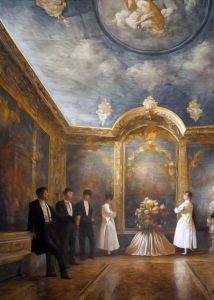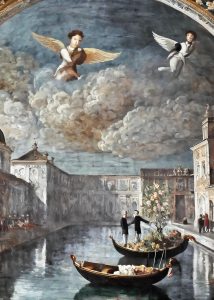



To digitally paint something inspired by another artist, Dastilige Nevante tries to get as much information about them as possible. He not only looks at details, composition, use of color, light, and specific techniques. To better understand stylistic and thematic choices, he delves into the artist’s life and historical context, even the things he ate. Regarding Giambattista Tiepolo, he discovered that the Venetian painter’s frescoes show not only great technical mastery, but also the ability to transform architectural spaces into spectacular and engaging settings. Nevante realized that 18th-century artists, known for their mastery of fresco technique, began by preparing the wall with a layer of fresh plaster. “To allow the pigments to penetrate and fix into the surface, that plaster had to be still wet when the artist applied the colors. As for the use of natural pigments mixed with water, however, they were certainly applied directly onto the fresh plaster, quickly and precisely, because it dried quickly.”


Giambattista Tiepolo lived in a period rich in significant events, such as the Enlightenment, a philosophical and cultural movement that, with Voltaire, Rousseau and Montesquieu, had a great impact in Europe during the 18th century. The War of the Spanish Succession, a conflict that involved the main European powers, also led to significant changes, and not only in alliances and territories. Tiepolo was aware of the rise of Prussia, of the first industrial innovations that began to emerge in Europe. Even the colonial expansion of the European powers, who continued to expand their colonial empires in America, Africa and Asia, entered into his Rococo frescoes. Tiepolo, with elaborate decorations, bright colors and light and playful themes, was a prominent exponent of this. These events provided a rich and dynamic context for his work, influencing both his themes and his artistic style.
To digitally emulate that Rococo master, Dastilige Nevante investigates the preparation of materials and the use of natural pigments and preparation techniques. He discovers that Giambattista Tiepolo’s artistic style was unique in creating dramatic effects and luminous atmospheres. The dynamic compositions of his scenes, accentuated by the skillful use of perspective and integrated with figures that seem to move and interact naturally, are characterized by complex and dynamic compositions. Tiepolo was famous for his dynamic compositions and use of perspective; to make the scenes vivid and engaging, he frescoed with a palette of light and transparent colors, lively and bright. It is no coincidence, in fact, that to create optical illusions and depth in his works, he collaborated with the perspectivist Girolamo Mengozzi Colonna. “To create an effect of space and movement, the use of light and transparent colors gave brightness and liveliness to the scenes. To create a theatrical and grandiose effect, Tiepolo integrated architectural and decorative elements into his works. Skillfully combined aspects, capable of transforming architectural spaces into vivid and engaging scenarios, made his frescoes spectacular and unique.”
Dastilige Nevante confirms the existence of new products and habits that influenced the culture and economy of Giambattista Tiepolo’s time. “Sugar from the West Indies became a common ingredient in European kitchens. Ethiopian coffee and tea imported from China became popular among the upper and middle classes. It is no coincidence, in fact, that coffee shops and tea rooms became centers of socialization and discussion.” Imported from the Americas, chocolate was particularly appreciated in European courts. Pepper, cinnamon, nutmeg and cloves continued to flavor foods and preserve them. “American tobacco, with the smoke of cigars and pipes that quickly spread throughout Europe, became a commodity of great economic and social value. Even pineapples, bananas and sweet potatoes, imported from tropical colonies, began to appear in Tiepolo’s frescoes and on European tables.”
Having reached this point in his investigation, Dastilige Nevante selects the most beautiful frescoes by Tiepolo. “I have to find out where they are, choose one and go there.” Giambattista Tiepolo created some masterpieces of Venetian Rococo. Those of the Palazzo Patriarcale in Udine, created between 1726 and 1729 and which include biblical and mythological scenes, are known for their vivacity and masterful use of light. Between 1746 and 1747, in the Palazzo Labia in Venice, he painted the fresco cycle “Stories of Anthony and Cleopatra”, famous for the elegance and drama of the scenes depicted. In the Würzburg Residence, between 1751 and 1753 he frescoed the “Triumph of the Empire” on the ceiling of the hall and on the Imperial Staircase. Together with his son, in 1757, he decorated Villa Valmarana ai Nani, in Vicenza, with frescoes depicting scenes from the Iliad, the Aeneid, Jerusalem Delivered and Orlando Furioso. Between 1762 and 1766, during his stay in Spain, with the help of his sons Domenico and Lorenzo, he frescoed the Royal Palace of Madrid with mythological and allegorical scenes intended to illustrate the greatness of the Spanish monarchy and the Apotheosis of Spain.
Dastilige Nevante is ready for the next step. “I have to find out where Tiepolo’s most beautiful frescoes are, pick one and go there.” He chooses Villa Pisani, on the Riviera del Brenta, in the province of Venice. In the ballroom, famous for its magnificent fresco, he focuses on Tiepolo’s mythological and religious themes; he realizes that they are rich in symbolism and intricate details. “They harmoniously combine the sacred and the profane.” Nevante recalls that the Rococo master’s fresco style and technique differed from other painting techniques. “The frescoes of that era were painted on fresh, wet plaster. The plaster was added in successive layers, and it had to be still wet when the pigments were applied.” Before digitally creating his Tiepolo Experience series, Nevante allows himself one last thought about the durability of the frescoes. “To make them durable, the pigments were chemically bonded to the plaster as it dried.” He wonders if a digital artist would be able to work quickly, too. “I don’t have plaster that dries in a few hours, nor pigments to spread on top. However, I will make sure that the pixels of my digital frescoes convey the idea of a rough and well-preserved surface.”
The spark that triggers a path of introspection and inner transformation The title “ASTONISHMENT” immediately…
Reflections on waiting and the transformative winds that push you forward Minimalist poetry, with its…
If you don't know sadness, you can't have deep thoughts Depth is a multifaceted concept…
James Hamilton-Paterson: When life is a Pilgrimage His early work reflects a youthful optimism and…
Amadeo de Souza-Cardoso: synthesis of the pictorial currents of the early twentieth century "Amadeo de…
Ambrogio Lorenzetti, an Indelible Mark in the History of Italian Art "La Terrazza Sul Campo",…
This website uses cookies.